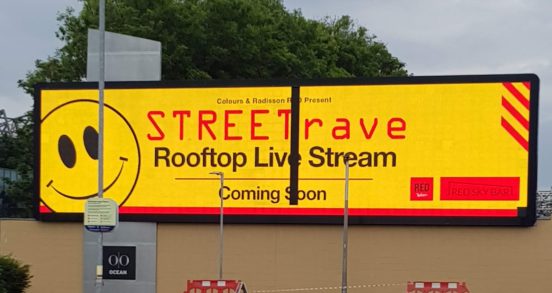Much has been written in the media about changes in consumer spending over the lockdown period. More food and alcohol, fewer non-essential goods such as clothing and footwear, furniture and recreational goods. The patterns of our spending have reflected constraints on our mobility and perceived risks of contracting the virus in public spaces, as well as parts of the economy shutting down, such as the travel and leisure industry. The question is, now that restarting of the economy is on the government’s horizon, will we revert back to old consumption habits once lockdown is over? From the evidence in my photos, I believe the marketers of these goods and services think perhaps not.
I took the photos on 9th June, at the Phase 1 stage in the Scottish Government’s strategy to exit from lockdown. The photos show a series of advertisements from a rotating billboard near Murrayfield. I thought the products were particularly emblematic of the times: Wine delivered to your door; A virtual livestreamed rave; A high-spec indoor fitness bike; and learning to write packs for children. Despite lockdown easing, the investment in advertising these products and services suggests that marketers predict our consumption habits will remain home-oriented in the near future. How might a sociologist analyse such shifts in consumption practices?
The sociology of consumption is a vast field, having seen numerous ‘turns’ over years, but can commonly be understood as the ‘social organization of activities through which items are incorporated, deployed, and disposed of’ (Warde, 2015, p. 118). The ‘practice turn’ in the sociology of consumption is informed by social practice theory. This seam of thought de-centres the human actor in consumption, but without prioritising structure or agency. A social practice is seen by Shove et al (2012) as integrated elements of materials (objects, tools and infrastructures), competencies (knowledge and embodied skills) and meanings (cultural conventions, expectations and socially shared meanings). Social practices interlock, for example the practices of mobility, shopping and eating. They are dynamic, emerging or disappearing when links between their defining elements are made or broken.
Within this framework, the rupturing of links due to COVID-19 (for example, access to materials brought about by lockdown measures and economic shutdown) has resulted in new practices emerging, in part due to competencies to perform these having been developed during this period. For example, school closures and the need for home schooling have demanded parents learn skills of teaching, and the enforcement of spending leisure time at home has developed competencies in using technology for socialising. The meanings element of some practices may have changed due to narratives of risk, so that having wine delivered to your door could mean feeling safer (than going to the supermarket) or greater convenience. The meaning of taking exercise on a static bike may be related to expectations of continued gym closure, efforts towards preventative healthcare, or the need to spend more time at home due to caring responsibilities.
I wonder whether – in the coming months and years as we start to feel the financial pinch of the economic downturn, we will see social practices shift again, with products advertised on these billboards reflecting a shift towards constrained household budgets and frugality?
This piece is reproduced from Edinburgh Decameron: Lockdown Sociology at Work.
Lisa Howard is a PhD researcher researching climate change and personal life.
References
Shove, E., Pantzar, M., & Watson, M. (2012). The dynamics of social practice: Everyday life and how it changes. In The Dynamics of Social Practice: Everyday Life and How it Changes.
Warde, A. (2015). The Sociology of Consumption: Its Recent Development. Annual Review of Sociology, 41, 117–123.













Comments by